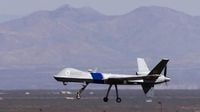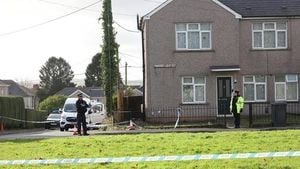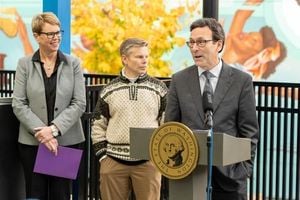In a move that has sparked a heated debate over privacy, civil liberties, and the future of protest surveillance in America, the Department of Homeland Security (DHS) deployed MQ-9 Predator drones over Los Angeles in June 2025 to monitor anti-ICE demonstrations. According to reporting by the Los Angeles Times, this marked the first domestic use of such military-grade drones since 2020, and has since prompted a wave of legislative action and public outcry.
The anti-ICE protests, which drew thousands of demonstrators into the streets of Los Angeles, were closely watched from above by these unmanned aerial vehicles. The drones, flying at an altitude of 20,000 feet, were not simply gathering footage for DHS alone. Instead, they provided real-time video feeds to a range of government agencies, including Immigration and Customs Enforcement (ICE) and the military, as confirmed by Los Angeles Times sources. The surveillance spanned several days, capturing the movements and activities of protestors across the city.
For many observers, this was an unsettling escalation. The MQ-9 Predator drones are no ordinary aircraft. Equipped with advanced infrared sensors and high-definition cameras, they were originally designed for surveillance operations along the U.S.-Mexico border, first being deployed there in 2005. Their capabilities far exceed those of typical law enforcement helicopters or civilian drones, and their presence above the city’s protests represented a significant shift in policy regarding domestic surveillance.
While some officials within DHS and associated agencies have argued that such technology offers valuable situational awareness—helping to ensure public safety and coordinate emergency responses—critics are far from convinced. Human rights groups, privacy advocates, and civil liberties organizations have raised the alarm about what they see as a dangerous precedent. Their central concern? That the use of military-grade surveillance technology on U.S. soil, particularly to monitor peaceful protests, could constitute a violation of First Amendment rights and erode the freedoms that form the bedrock of American democracy.
“This is not just about Los Angeles, this affects the entire country,” said Representative Jimmy Gomez, a Democrat representing Los Angeles, in a statement to the press following the drone deployments. Gomez’s words, reported by the Los Angeles Times, captured the national resonance of the issue. In response to the events in June, Gomez introduced a bill in July 2025 aimed squarely at restricting the use of military drones over demonstrators on U.S. soil. The proposed legislation seeks to draw a clear line between the tools appropriate for border security and those that should be kept far from domestic protests.
Support for Gomez’s bill has been swift and, at least locally, overwhelming. On September 16, 2025, the Los Angeles City Council voted unanimously to endorse the legislation. Council members emphasized the importance of protecting residents’ rights to peaceful protest, underscoring a broad consensus that while public safety matters, it should not come at the expense of constitutional freedoms. The council’s action, reported by multiple local outlets, signals a growing desire among city leaders to push back against what they see as federal overreach.
But the debate is far from one-sided. Some officials and supporters of the drone program argue that, in an era marked by large-scale demonstrations and occasional unrest, advanced surveillance tools are necessary to maintain order and protect both protestors and the public. They point to the drones’ ability to provide comprehensive situational awareness, helping authorities respond more quickly to emergencies or threats. Still, even among those who see value in such technology, there is an acknowledgment that clear guidelines and oversight are essential to prevent abuse.
Human rights groups, however, remain deeply skeptical. They warn that the normalization of military-grade surveillance in American cities could chill free speech and intimidate those who wish to exercise their right to assemble. The American Civil Liberties Union (ACLU) and other organizations have pointed to the First Amendment, arguing that the right to protest is sacrosanct and must not be undermined by state surveillance. While not all critics believe that the use of drones is inherently unlawful, many insist that the current regulatory framework is inadequate to safeguard civil liberties in the face of rapidly advancing technology.
“The use of these drones over Los Angeles represents a significant shift in policy,” one local activist told Los Angeles Times. “We’re not talking about border security anymore. We’re talking about Americans exercising their basic rights.”
This sentiment has found resonance beyond activist circles. Legal scholars have also weighed in, noting that while the Supreme Court has not yet ruled directly on the use of drones for protest surveillance, there is a long history of jurisprudence supporting the right to privacy and freedom of assembly. Some point to the 1967 ruling in Katz v. United States, which established that the Fourth Amendment protects people, not just places, from unreasonable searches and seizures—a principle that, they argue, should extend to aerial surveillance of public gatherings.
The broader context for this controversy is a national reckoning over the balance between security and liberty. Since the early 2000s, the expansion of surveillance technology—first at the border, then in urban centers—has been met with both enthusiasm and alarm. The events in Los Angeles have crystallized these tensions, forcing lawmakers, law enforcement, and the public to confront difficult questions about the future of protest, privacy, and policing in America.
For many Angelenos, the sight—albeit invisible from the ground—of Predator drones circling above their heads during a protest has become a symbol of a changing era. It raises uncomfortable questions: How much surveillance is too much? Who decides when and how such technology is deployed? And what safeguards are in place to ensure that the rights of ordinary citizens are not trampled in the name of security?
As the debate continues, the fate of Representative Gomez’s bill remains uncertain at the federal level. But in Los Angeles, at least, the message from city leaders is clear: The right to protest must be protected, and the use of military-grade surveillance tools in America’s cities demands urgent scrutiny and robust regulation.
With the eyes of the nation now fixed on Los Angeles, the outcome of this legislative battle could set the tone for how American cities balance security and civil liberties in an increasingly surveilled world.




